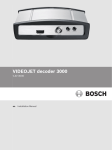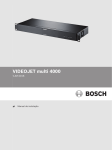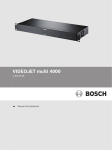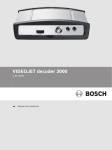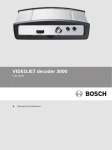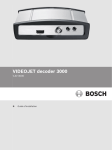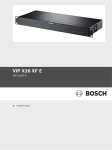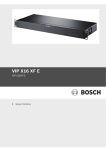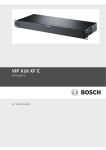Download Bosch VJM-4016 Installation manual
Transcript
VIDEOJET multi 4000 VJM-4016 en Installation Manual VIDEOJET multi 4000 Table of Contents | en 3 Table of contents 1 Safety 5 1.1 Electric shock hazard 5 1.2 Installation and operation 5 1.3 Maintenance and repair 6 2 Short information 7 2.1 About this manual 7 2.2 Conventions in this manual 7 2.3 Intended use 7 2.4 EU Directives 7 2.5 Rating plate 7 3 System overview 8 3.1 Parts included 8 3.2 System requirements 8 3.3 Overview of functions 3.4 Connections, controls and displays 11 3.4.1 Front view 11 3.4.2 Rear view 12 4 Installation 13 4.1 Preparations 13 4.2 Installing in a switch cabinet 13 5 Connection 15 5.1 Connecting cameras 15 5.2 Establishing the network connection 16 5.3 Connecting audio 17 5.4 Connecting alarm inputs and relay output 18 5.5 Creating a serial connection 19 5.6 Power on/power off 20 6 Configuration 21 6.1 Setup 21 6.2 Setup using Video Client 21 7 Troubleshooting 23 7.1 Contact 23 7.2 General malfunctions 23 7.3 Malfunctions with iSCSI connections 24 7.4 LEDs 24 7.5 Processor load 25 7.6 Network connection 25 7.7 Terminal block 25 7.8 Copyrights 26 8 Maintenance 27 8.1 Updates 27 8.2 Factory reset 27 8.3 Repairs 27 9 Decommissioning 28 9.1 Transfer 28 9.2 Disposal 28 Bosch Sicherheitssysteme GmbH 8 Installation Manual 2014.02 | V1 | F.01U.298.750 4 en | Table of Contents VIDEOJET multi 4000 10 Technical data 29 10.1 Electrical 29 10.2 Mechanical 29 10.3 Environmental conditions 29 10.4 Standards 29 2014.02 | V1 | F.01U.298.750 Installation Manual Bosch Sicherheitssysteme GmbH VIDEOJET multi 4000 Safety | en 1 Safety 1.1 Electric shock hazard – 5 Never attempt to connect the unit to any power network other than the type for which it is intended. – Connect the unit to an earthed mains socket-outlet. – Never open the housing. – If a fault occurs, disconnect the unit from the power supply and from all other units. – Install the unit only in a dry, weather-protected location. – When installing in a switch cabinet, ensure that the unit has sufficient grounding. – If safe operation of the unit cannot be ensured, remove it from service and secure it to prevent unauthorized operation. In such cases, have the unit checked by Bosch Security Systems. Safe operation is no longer possible in the following cases: – if there is visible damage to the unit or power cables, – if the unit no longer operates correctly, – if the unit has been exposed to rain or moisture, – if foreign bodies have penetrated the unit, – after long storage under adverse conditions, or – after exposure to extreme stress in transit. Viktige sikkerhetsinstruksjoner (Norway only) Utstyr som er koplet til beskyttelsesjord via nettplugg og/eller via annet jordtilkoplet utstyr – og er tilkoplet et kabel-TV nett, kan forårsake brannfare. For å unngå dette skal det ved tilkopling av utstyret til kabel-TV nettet installeres en galvanisk isolator mellom utstyret og kabel-TV nettet. Viktiga säkerhetsinstruktioner (Sweden only) Utrustning som är kopplad till skyddsjord via jordat vägguttag och/eller via annan utrustning och samtidigt är kopplad till kabel-TV nät kan i vissa fall medfőra risk főr brand. Főr att undvika detta skall vid anslutning av utrustningen till kabel-TVnät galvanisk isolator finnas mellan utrustningen och kabel-TV nätet. 1.2 Installation and operation – The relevant electrical engineering regulations and guidelines must be complied with at all times during installation. – Relevant knowledge of network technology is required to install the unit. – Before installing or operating the unit, make sure you have read and understood the documentation for the other equipment connected to it, such as cameras. The documentation contains important safety instructions and information about permitted uses. – Perform only the installation and operation steps described in this manual. Any other actions may lead to personal injury, damage to property or damage to the equipment. Please ensure the following installation conditions: – Do not install the unit close to heaters or other heat sources. Avoid locations exposed to direct sunlight. – Allow sufficient space for running cables. – Ensure that the unit has adequate ventilation. Bear the total heat output in mind, particularly when installing multiple units in a switch cabinet. Bosch Sicherheitssysteme GmbH Installation Manual 2014.02 | V1 | F.01U.298.750 6 en | Safety VIDEOJET multi 4000 – When making connections, use only the cables supplied or use appropriate cables immune to electromagnetic interference. – Position and run all cables so that they are protected from damage, and provide adequate cable strain relief where needed. – When installing in a switch cabinet, ensure that the screw joints are free of tension and subject to as little mechanical stress as possible. Ensure that the unit has sufficient grounding. 1.3 Maintenance and repair – Never open the housing of the unit. The unit does not contain any user-serviceable parts. – Ensure that all maintenance or repair work is carried out only by qualified personnel (electrical engineers or network technology specialists). In case of doubt, contact your dealer's technical service center. 2014.02 | V1 | F.01U.298.750 Installation Manual Bosch Sicherheitssysteme GmbH VIDEOJET multi 4000 Short information | en 2 Short information 2.1 About this manual 7 This manual is intended for persons responsible for the installation and operation of the VIDEOJET multi 4000 encoder. International, national and any regional electrical engineering regulations must be followed at all times. Relevant knowledge of network technology is required. The manual describes the installation of the unit. Conventions in this manual 2.2 In this manual, the following symbols and notations are used to draw attention to special situations: Warning! ! Use of this signal word and symbol indicates that failure to follow the safety instructions described may endanger persons. It indicates a hazardous situation which, if not avoided, could result in death or serious injury. Caution! ! Use of this signal word and symbol indicates that failure to follow the safety instructions described may endanger persons. It indicates a hazardous situation which, if not avoided, could result in minor or moderate injury. Notice! Use of this signal word and symbol indicates that failure to follow the safety instructions described may cause damage to the unit or other equipment or may lead to data loss. 2.3 Intended use The VIDEOJET multi 4000 encoder transfers video, audio, and control signals over data networks (Ethernet LAN, Internet). The unit is intended for use with CCTV systems. Various functions can be triggered automatically by incorporating external alarm sensors. Other applications are not permitted. In the event of questions concerning the use of the unit which are not answered in this manual, please contact your sales partner or: Bosch Sicherheitssysteme GmbH Robert-Bosch-Ring 5 85630 Grasbrunn Germany www.boschsecurity.com 2.4 EU Directives The VIDEOJET multi 4000 encoder complies with the requirements of EU Directives 89/336 (Electromagnetic Compatibility) and 73/23, amended by 93/68 (Low Voltage Directive). 2.5 Rating plate For exact identification, the model name and serial number are inscribed on the bottom of the housing. Please make a note of this information before installation, if necessary, so as to have it to hand in case of questions or when ordering spare parts. Bosch Sicherheitssysteme GmbH Installation Manual 2014.02 | V1 | F.01U.298.750 8 en | System overview VIDEOJET multi 4000 3 System overview 3.1 Parts included – 1 VIDEOJET multi 4000 video encoder – 1 accessory bag – 1 Installation Manual – optional: 1 power cord (depending on the ordered product package) Notice! Check that the delivery is complete and in perfect condition. Arrange for the unit to be checked by Bosch Security Systems if you find any damage. 3.2 System requirements General requirements – Computer with Windows XP or Windows 7 operating system – Network access (Intranet or Internet) – Screen resolution at least 1,024 × 768 pixels – 16- or 32-bit color depth – Installed Oracle JVM Note: The Web browser must be configured to enable cookies to be set from the IP address of the unit. In Windows 7, deactivate protected mode on the Security tab under Internet Options. You can find notes on using Microsoft Internet Explorer in the online Help in Internet Explorer. Additional configuration and operational requirements You find the information on additional configuration and operational requirements in the Releaseletter document for the respective firmware. For the latest version of the firmware, required programs and controls, and the current version of the Video Client management software, access your Bosch product catalog on the Internet. 3.3 Overview of functions Network video server The VIDEOJET multi 4000 encoder is a compact network video server for 16 connected video sources. It is primarily designed for encoding video, audio and control data for transfer over an IP network. With its encoding in the H.264 format, the unit is ideally suited for making existing analog CCTV cameras IP-compatible and for remote access to digital VCRs and multiplexers. The use of existing networks means that integration with CCTV systems or local networks can be achieved quickly and easily. Video images from a single sender can be received simultaneously on multiple receivers. Audio signals can also be transmitted from and to compatible units. Dual Streaming The encoder uses the feature Dual Streaming to generate two independent IP video streams per channel, both at full 4CIF resolution and with full frame rate. Video encoding The VIDEOJET multi 4000 High Profile encoder uses the H.264 video compression standard. Thanks to efficient encoding, the data rate remains low even with high image quality and can also be adapted to local conditions within wide limits. 2014.02 | V1 | F.01U.298.750 Installation Manual Bosch Sicherheitssysteme GmbH System overview | en VIDEOJET multi 4000 9 Audio encoding The VIDEOJET multi 4000 encoder uses the G.711, AAC, and L16 audio compression standards. G.711 is the default setting for live transmission. For recording the default setting is AAC. When configuring with a Web browser, you can select your preferred standard for recording. Using video management systems, this is also true for live audio. Viewing View the encoder video on a PC using a Web browser, in Bosch Video Management System, or integrate it into another video management system. By routing the IP video to a highperformance VIDEOJET decoder or to Monitor Wall, you can present the video with ultimate clarity. Recording You can record each video input independently on different media. Thus video can be recorded centrally on iSCSI drives managed by VRM. The encoder features a highly flexible recording scheduler, providing up to ten programmable recording profiles and allowing individually assigned camera profiles. With these profiles, you can accelerate the frame rate as well as increase the quality on alarm, saving recording space during non-alarm periods. Multicast In suitably configured networks, the multicast function enables simultaneous real-time video transmission to multiple receivers. The UDP and IGMP V2 protocols must be implemented on the network for this function. Access security The encoder offers various security levels for accessing the network, the unit, and the data channels. As well as password protection with up to three levels, they support 802.1x authentication using a RADIUS server for identification. You can secure Web browser access by HTTPS using an SSL certificate that is stored in the unit. For total data protection, each communication channel—video, audio, or serial I/O—can be independently AES encrypted. Remote control For remote control of external units such as pan or tilt heads for cameras or motorized zoom lenses, control data is transmitted via the encoder's bidirectional serial interface. This interface can also be used to transmit transparent data. Intelligence The encoder comes with built-in MOTION+ video motion detection. This motion detection algorithm is based on pixel change and includes object size filtering capabilities. On alarm, the device can send an e‑mail with JPEG images attached. ONVIF conformance Conformance to ONVIF 1.02 and ONVIF Profile S provides interoperability between network video products regardless of manufacturer. In addition, the firmware of the device supports all applicable features of the ONVIF 2.2 specification. ONVIF conformant devices are able to exchange live video, audio, metadata, and control information and ensure that they are automatically discovered and connected to network applications such as video management systems. Bosch Sicherheitssysteme GmbH Installation Manual 2014.02 | V1 | F.01U.298.750 10 en | System overview VIDEOJET multi 4000 Summary The VIDEOJET multi 4000 encoder provides the following main functions: – Video, audio, and data transmission over IP data networks – Dual Streaming function for the encoder for simultaneous encoding with two individually – Multicast function for simultaneous image transmission to multiple receivers – 16 analog BNC composite video inputs (PAL/NTSC) – Video encoding according to international standard H.264 – Deinterlacing at video input and progressive encoding – Integrated Ethernet port (10/100/1000 Base-T) – Network-attached iSCSI recording – Transparent, bidirectional data channel via RS-232/RS-422/RS-485 serial interface – Configuration and remote control of all internal functions via TCP/IP, also secured via definable profiles HTTPS – Password protection to prevent unauthorized connection or configuration changes – 4 alarm inputs for external sensors (such as door contacts) – 1 relay output for switching external units (such as lamps or sirens) – Built-in video sensor for motion alarms – Event-controlled automatic connection – Convenient maintenance via uploads – Flexible encryption of control and data channels – Authentication according to international standard 802.1x – Bidirectional audio (mono) for line connections – Audio encoding according to international standards AAC, G.711, and L16 2014.02 | V1 | F.01U.298.750 Installation Manual Bosch Sicherheitssysteme GmbH VIDEOJET multi 4000 System overview | en 3.4 Connections, controls and displays 3.4.1 Front view 1 11 Factory reset button to restore factory default settings 2 LED ACTIVITY flashes during data transmission 3 LED LINK lights up when the unit is connected to the network 4 LED STATUS lights up during startup 5 LED CONNECT lights up when supplied with power after startup See also – LEDs, page 24 Bosch Sicherheitssysteme GmbH Installation Manual 2014.02 | V1 | F.01U.298.750 12 en | System overview 3.4.2 VIDEOJET multi 4000 Rear view 1 VIDEO IN 1 to VIDEO IN 16 video inputs BNC socket for connecting the video source 2 ETH RJ45 socket for connecting to an Ethernet LAN (local network), 10/100/1000 MBit Base-T 3 AUDIO IN audio connection (mono) 3.5 mm (1/8 in) stereo socket audio in for connecting two audio sources 4 Terminal block for alarm inputs, relay output and serial interface 5 AUDIO OUT audio connection (mono) 3.5 mm (1/8 in) stereo socket line-out for connecting one audio connection 6 Power supply input for connecting the power cable See also – LEDs, page 24 – Terminal block, page 25 2014.02 | V1 | F.01U.298.750 Installation Manual Bosch Sicherheitssysteme GmbH VIDEOJET multi 4000 Installation | en 4 Installation 4.1 Preparations 13 The VIDEOJET multi 4000 encoder is designed for installation in a switch cabinet. Mounting the unit in a 19-inch rack using the installation material supplied is a quick and easy operation. Please ensure the following installation conditions: – Do not install the unit close to heaters or other heat sources. Avoid locations exposed to direct sunlight. – Allow sufficient space for running cables. – Ensure that the unit has adequate ventilation. Bear the total heat output in mind, particularly when installing multiple units in a switch cabinet. – When making connections, use only the cables supplied or use appropriate cables immune to electromagnetic interference. – Position and run all cables so that they are protected from damage, and provide adequate cable strain relief where needed. 4.2 Installing in a switch cabinet Notice! When installing in a switch cabinet, ensure that there is sufficient ventilation for the unit. There must be at least 5 cm (1.97 in) of free space to the left and right of the unit and at least 10 cm (3.94 in) at the rear. The unit generates heat during operation. During installation, please note the maximum heat value of 79 BTU/h. When mounting additional units, direct contact with the encoder is permitted, provided that the surface temperature of the adjacent units does not exceed +50 °C (+122 °F). When installing in a switch cabinet, ensure that the screw joints are free of tension and subject to as little mechanical stress as possible. Ensure that the unit has sufficient grounding. 1. Prepare the switch cabinet in such a manner that you are easily able to insert the unit directly at the installation point. 2. Place the cage nuts in the corresponding drillings or spaces in the switch cabinet frame. 3. Lift the unit into the switch cabinet frame and insert the fastening screws together with the washers. 4. Tighten the screws one after the other and then check once more that all the screws are tight. Bosch Sicherheitssysteme GmbH Installation Manual 2014.02 | V1 | F.01U.298.750 14 en | Installation 2014.02 | V1 | F.01U.298.750 VIDEOJET multi 4000 Installation Manual Bosch Sicherheitssysteme GmbH VIDEOJET multi 4000 Connection | en 5 Connection 5.1 Connecting cameras 15 You can connect a maximum of 16 video sources to the VIDEOJET multi 4000 encoder. Any cameras and other video sources that produce a standard PAL or NTSC signal are suitable. 4 Connect each of the cameras or other video sources to BNC sockets VIDEO IN 1 to VIDEO IN 16 using a video cable (75 ohm, BNC plug). Note that termination is always on. Bosch Sicherheitssysteme GmbH Installation Manual 2014.02 | V1 | F.01U.298.750 16 5.2 en | Connection VIDEOJET multi 4000 Establishing the network connection You can connect the unit to a 10/100/1000 Base-T network using a standard UTP category 5 cable with RJ45 plugs. 4 2014.02 | V1 | F.01U.298.750 Connect the unit to the network via the ETH socket. Installation Manual Bosch Sicherheitssysteme GmbH VIDEOJET multi 4000 5.3 Connection | en 17 Connecting audio The unit has two audio ports for audio line signals. The audio signals are transmitted two-way and in sync with the video signals. The following specifications should be complied with in all cases. 2 × audio in: Impedance 9 kohm typ., 5.5 Vp-p max. input voltage; microphone amplifier 60 dB max. 1 × line out: 3.0 Vp-p typ. output voltage at 10 kohm impedance The stereo plug must be connected as follows: Contact AUDIO IN AUDIO OUT Tip Channel 1 Channel 1 Middle ring Channel 2 — Lower ring Ground Ground 1. Connect an audio source to the AUDIO IN socket with a 3.5 mm (1/8 in) stereo plug. 2. Connect an audio receiver with line-in connection to the AUDIO OUT socket with a 3.5 mm (1/8 in) stereo plug. Note that the audio function is not activated by default. To use audio connections activate the corresponding setting when configuring the unit. Bosch Sicherheitssysteme GmbH Installation Manual 2014.02 | V1 | F.01U.298.750 18 5.4 en | Connection VIDEOJET multi 4000 Connecting alarm inputs and relay output Notice! For correct connection of alarm inputs and relay outputs, observe the labelling on the unit. Alarm inputs The unit has 4 alarm inputs on the terminal block. The alarm inputs are used to connect to external alarm devices such as door contacts or sensors. With the appropriate configuration, an alarm sensor can automatically connect the unit to a remote location, for example. A zero potential closing contact or switch can be used as the actuator. If possible, use a bounce-free contact system as the actuator. 1. Connect the lines to the appropriate terminals on the terminal block (IN1 to IN4) and check that the connections are secure. 2. Connect each alarm input to a ground contact (GND). Relay output The unit has one relay output for switching external units such as lamps or alarm sirens. You can operate the relay output manually while there is an active connection to the unit. The output can also be configured to automatically activate sirens or other alarm units in response to an alarm signal. The relay output is also located on the terminal block. Notice! A maximum load of 30 Vp-p (SELV) and 200 mA may be applied to the relay contacts. 1. Connect the lines to the appropriate terminals R on the terminal block and check that the connections are secure. 2014.02 | V1 | F.01U.298.750 Installation Manual Bosch Sicherheitssysteme GmbH VIDEOJET multi 4000 Connection | en 2. 19 Connect the terminal block to the socket on the unit observing the labeling. See also – 5.5 Terminal block, page 25 Creating a serial connection Notice! For correct connection, observe the labelling on the unit. The bidirectional data interface is used to control units connected to the VIDEOJET multi 4000 encoder, such as a dome camera with a motorized lens. The connection supports the RS-232, RS-422, and RS-485 transmission standards. A video connection is necessary to transmit transparent data. The serial interface is also located on the terminal block. The range of controllable equipment is expanding constantly. The manufacturers of the relevant equipment provide specific information on installation and control. Please take note of the appropriate documentation when installing and operating the peripheral to be controlled. The documentation contains important safety instructions and information about permitted uses. 1. If you require a serial connection to the unit, connect the relevant cables to the terminal block and check that the connections are secure. 2. Connect the terminal block to the socket on the unit observing the labeling. See also – Terminal block, page 25 Bosch Sicherheitssysteme GmbH Installation Manual 2014.02 | V1 | F.01U.298.750 20 5.6 en | Connection VIDEOJET multi 4000 Power on/power off Depending on the ordered product package, the unit is delivered together with a power cord. Notice! Use only a suitable power cord. Where necessary, use suitable facilities to ensure that the power supply is free of interference such as voltage surges, spikes or brownouts. Connect the unit to an earthed mains socket-outlet. Do not connect the unit to the power supply until all other connections have been made. 1. Make sure to use a suitable power cord and connect it to the unit. 2. Plug the power cord into the mains. The unit is ready for use as soon as the CONNECT LED lights up. Provided the network connection has been correctly made, the LINK LED also lights up. The flashing LED ACTIVITY signals traffic on the network. See also – 2014.02 | V1 | F.01U.298.750 LEDs, page 24 Installation Manual Bosch Sicherheitssysteme GmbH VIDEOJET multi 4000 Configuration | en 6 Configuration 6.1 Setup 21 Before you can operate the unit within your network, it must have a valid IP address for your network and a compatible subnet mask. Note: As a default DHCP is enabled in the unit’s network settings. With an active DHCP server in the network you must know the IP address assigned by the DHCP server to operate the unit. The following default address is preset at the factory: 192.168.0.1 The setup procedure is carried out via our Video Client software or other management systems. All information regarding the configuration can be found in the relevant documentation of the video management system in use. 6.2 Setup using Video Client For the current version of our Video Client management software, access your Bosch product catalog on the Internet. This program allows you to implement and set up the unit in the network quickly and conveniently. Installing the program 1. Download Video Client from the Bosch product catalog on the Internet. 2. Unzip the file. 3. Double-click the installer file. 4. Follow the instructions on the screen to complete the installation. Configuring the unit You can start Video Client immediately after installation. 1. Double-click the icon on the desktop to start the program. Alternatively, start the application via the Start button and the Programs menu (path: Start/Programs/ Bosch Video Client/Bosch Video Client). 2. When the program is started for the first time, a wizard opens to help you detect and configure devices on the network. 3. If the wizard does not start automatically, click to open the Configuration Manager application. Then, click Configuration Wizard... on the Tools menu. 4. Follow the instructions given in the Configuration Wizard window. Bosch Sicherheitssysteme GmbH Installation Manual 2014.02 | V1 | F.01U.298.750 22 en | Configuration VIDEOJET multi 4000 Additional parameters You can check and set additional parameters with the assistance of the Configuration Manager application in Video Client. You can find detailed information on this in the documentation for these applications. Note that the audio function is not activated by default. To use audio connections activate the corresponding setting when configuring the unit. 2014.02 | V1 | F.01U.298.750 Installation Manual Bosch Sicherheitssysteme GmbH VIDEOJET multi 4000 Troubleshooting | en 7 Troubleshooting 7.1 Contact 23 If you are unable to resolve a malfunction, please contact your supplier or systems integrator, or go directly to Bosch Security Systems Customer Service. The following tables are intended to help you identify the causes of malfunctions and correct them where possible. 7.2 General malfunctions Malfunction Possible causes Recommended solution No image transmission Camera error. Connect local monitor to the to remote station. camera and check the camera function. Faulty cable connections. Check all cables, plugs, contacts and connections. PAL camera connected after Reboot the unit. booting. No connection The unit's configuration. established, no image transmission. Check all configuration parameters. Faulty installation. Check all cables, plugs, contacts and connections. Wrong IP address. Check the IP addresses. Faulty data transmission within Check the data transmission the LAN. with e.g. ping. The maximum number of Wait until there is a free connections has been reached. connection and then call the unit again. No audio transmission to Hardware fault. Check that all connected audio remote station. units are operating correctly. Faulty cable connections. Check all cables, plugs, contacts and connections. Incorrect configuration. Check audio parameters. The audio connection is already Wait until the connection is in use by another receiver. free and then call the unit again. The unit does not report an alarm. Alarm source is not selected. Check alarm source settings. No alarm response specified. Specify the desired alarm response, change the IP address, if necessary. Bosch Sicherheitssysteme GmbH Installation Manual 2014.02 | V1 | F.01U.298.750 24 en | Troubleshooting VIDEOJET multi 4000 Malfunction Possible causes Recommended solution Control of cameras or The cable connection between Check all cable connections other units is not the serial interface and the and ensure all plugs are possible. connected unit is not correct. properly fitted. The interface parameters do Make sure that the settings of not match those of the other all units involved are unit connected. compatible. The unit is not Power failure during Have the unit checked by operational after a programming by firmware file. Customer Service and replace firmware upload. it, if necessary. Incorrect firmware file. Enter the IP address of the unit followed by /main.htm in your Web browser and repeat the upload. Placeholder with a red JVM not installed on your Install Oracle JVM from the cross instead of the computer or not activated. Bosch product catalog on the ActiveX components. Web browser contains Internet. Active proxy server in network. empty fields. Create a rule in the local computer's proxy settings to exclude local IP addresses. 7.3 Malfunctions with iSCSI connections Malfunction Possible causes Recommended solution After connecting to the Incorrect LUN mapping during Check the iSCSI system iSCSI target, no LUNs iSCSI system configuration. configuration and reconnect. After connecting to the The LUN list could not be read, Check the iSCSI system iSCSI target, "LUN FAIL" as it was assigned to the wrong configuration and reconnect. appears below a node. network interface. LUN mapping is not Some iSCSI systems do not possible. support the use of an initiator are displayed. Delete the initiator extension. extension. 7.4 LEDs The unit has LEDs on its front and rear panels that show the operating status and can give indications of possible malfunctions: ACTIVITY LED Flashes: Traffic on the network. LINK LED Lights up: 2014.02 | V1 | F.01U.298.750 Network connection established. Installation Manual Bosch Sicherheitssysteme GmbH VIDEOJET multi 4000 Troubleshooting | en 25 STATUS LED Lights up: Startup in progress. Flashes: The unit is faulty, for example following failed firmware upload. CONNECT LED Lights up: The unit is switched on and startup completed. Flashes: Video connection active. RJ45 socket LEDs Left LED flashes (as ACTIVITY Traffic on the network. LED): Right LED lights up (as LINK Network connection established. LED): 7.5 Processor load If the unit is accessed via the Web browser, you will see the processor load indicator bar in the top right of the window next to the information icon . You can obtain additional information to help you when troubleshooting or fine tuning the unit. The values indicate the proportions of the individual functions on the coder load, shown as percentages. Move the cursor over the graphic indicator. Some additional numerical values are also 4 displayed. 7.6 Network connection You can display information about the network connection. To do this, move the cursor over . 7.7 Link Ethernet link type UL Uplink, speed of the outgoing data traffic DL Downlink, speed of the incoming data traffic Terminal block The terminal block has several contacts for: – Serial data transmission – 4 alarm inputs – 1 relay output Pin assignment serial interface Options for using the serial interface include transferring transparent data, controlling connected units or operating the unit with a terminal program. Bosch Sicherheitssysteme GmbH Installation Manual 2014.02 | V1 | F.01U.298.750 26 en | Troubleshooting VIDEOJET multi 4000 The serial interface supports the RS-232, RS-422 and RS-485 transmission standards. The mode used depends on the current configuration. The pin assignment of the serial interface depends on the interface mode used: Contact RS-232 mode RS-422 mode RS-485 mode CTS — RxD- (receive data minus) — TXD TxD (transmit data) TxD- (transmit data minus) Data- RTS — TxD+ (transmit data plus) Data+ RXD RxD (receive data) RxD+ (receive data plus) — GND GND (ground) — — Pin assignment I/O Contact Function IN1 Input alarm 1 IN2 Input alarm 2 IN3 Input alarm 3 IN4 Input alarm 4 GND Ground R Relay output Connect each alarm input to a ground contact (GND). 7.8 Copyrights Fonts The firmware uses the fonts "Adobe-Helvetica-Bold-R-Normal--24-240-75-75-P-138-ISO10646-1" and "Adobe-Helvetica-Bold-R-Normal--12-120-75-75-P-70-ISO10646-1" under the following copyright: Copyright 1984-1989, 1994 Adobe Systems Incorporated. Copyright 1988, 1994 Digital Equipment Corporation. Permission to use, copy, modify, distribute and sell this software and its documentation for any purpose and without fee is hereby granted, provided that the above copyright notices appear in all copies and that both those copyright notices and this permission notice appear in supporting documentation, and that the names of Adobe Systems and Digital Equipment Corporation not be used in advertising or publicity pertaining to distribution of the software without specific, written prior permission. Software This software is based in part on the work of the Independent JPEG Group. Audio AAC audio technology licensed by Fraunhofer IIS (http://www.iis.fraunhofer.de/amm/). 2014.02 | V1 | F.01U.298.750 Installation Manual Bosch Sicherheitssysteme GmbH VIDEOJET multi 4000 Maintenance | en 8 Maintenance 8.1 Updates 27 Firmware updates are carried out via our Video Client software or other management systems in use. Please refer to the relevant documentation. 8.2 Factory reset You can use the factory reset button to restore the unit to its original settings. Any changes to the settings are overwritten by the factory defaults. A reset may be necessary, for example, if the unit has invalid settings that prevent it from functioning as desired. 1. Using a pointed object, press the factory reset button located on the front panel until the STATUS LED flashes. All settings will revert to their defaults. 2. The unit is ready for configuration as soon as the CONNECT LED lights up. See also – 8.3 Configuration, page 21 Repairs – Never open the housing of the unit. The unit does not contain any user-serviceable parts. – Ensure that all maintenance or repair work is carried out only by qualified personnel (electrical engineers or network technology specialists). In case of doubt, contact your dealer's technical service center. Bosch Sicherheitssysteme GmbH Installation Manual 2014.02 | V1 | F.01U.298.750 28 en | Decommissioning VIDEOJET multi 4000 9 Decommissioning 9.1 Transfer VIDEOJET multi 4000 should only be passed on together with this installation manual. 9.2 Disposal Your Bosch product is designed and manufactured with high-quality materials and components which can be recycled and reused. This symbol means that electrical and electronic equipment, at their end-of-life, should be disposed of separately from your household waste. In the European Union, there are separate collection systems for used electrical and electronic products. Please dispose of this equipment at your local community waste collection/recycling center. 2014.02 | V1 | F.01U.298.750 Installation Manual Bosch Sicherheitssysteme GmbH VIDEOJET multi 4000 Technical data | en 10 Technical data 10.1 Electrical 10.2 Input voltage 100 to 240 V AC, 47 to 63 Hz Input current 0.32 to 0.15 A Power consumption 23 W max Connectors IEC 320 C14 29 Mechanical Dimensions (H × W ×D) 44 × 443 × 157 mm (1.732 × 17.441 × 6.181 in), without brackets including BNC sockets Weight Approx. 1.7 kg (3.7 lb) Video 16 × BNC socket, 75 ohm, terminated Analog composite, 0.7 to 1.2 Vp-p, NTSC or PAL Audio 2 × 3.5 mm (1/8 in) stereo socket (2 × mono in, microphone/line; 1 × mono line out) Signal line in 9 kohm typical, 5.5 Vp-p max, microphone amplifier 60 dB max Signal line out 3.0 Vp-p at 10 kohm typical Ethernet 10/100/1000 Base-T, auto-sensing, half/full duplex, RJ45 COM port 1 × RS-232/RS-422/RS-485, bidirectional, push-in terminal Alarm 4 × push-in terminal input (non-isolated closing contact), activation resistance 10 ohm max Relay 1 × push-in terminal output 30 Vp-p (SELV), 200 mA Display 4 × LED (ACTIVITY, LINK, STATUS, CONNECT) on the front panel 2 × LED (data transfer, network connection) on the rear panel 10.3 10.4 Environmental conditions Operating temperature 0 °C to +50 °C (+32 °F to +122 °F) Storage temperature 0 °C to +50 °C (+32 °F to +122 °F) Relative humidity 0 to 95% atmospheric humidity, non-condensing Thermal value 79 BTU/h max Standards Video standards PAL, NTSC Video coding protocols H.264 High Profile (ISO/IEC 14496-10) M-JPEG Video data rates 9.6 kbps to 2 Mbps per channel Connections Min. 16 simultaneous unicast/multicast Image resolutions 4CIF 704 × 576/480 (PAL/NTSC) GOP structure Bosch Sicherheitssysteme GmbH I, IP Installation Manual 2014.02 | V1 | F.01U.298.750 30 en | Technical data VIDEOJET multi 4000 Total delay 260 ms typical Dual Streaming Full performance and full frame rate on both streams for every video input channel Frame rate 1 to 25/30 ips (PAL/NTSC) Audio standards G.711, L16, AAC-LC Audio frequency rate G.711: 300 Hz to 3.4 kHz L16: 300 Hz to 6.4 kHz AAC-LC: 300 Hz to 6.4 kHz Audio sampling rate G.711: 8 kHz L16: 16 kHz AAC-LC: 16 kHz Audio data rate G.711: 80 kbps L16: 640 kbps AAC-LC: 48 kbps Signal-to-noise ratio > 50 dB Network protocols IPv4, IPv6, UDP, TCP, HTTP, HTTPS, RTP/RTCP, IGMP V2/V3, ICMP, ICMPv6, RTSP, FTP, Telnet, ARP, DHCP, SNTP, 802.1x, DNS, DNSv6, DDNS (DynDNS.org, selfHOST.de, no-ip.com), SMTP, iSCSI, UPnP (SSDP), DiffServ (QoS), LLDP, SOAP, Dropbox, CHAP, digest authentication Encryption 2014.02 | V1 | F.01U.298.750 TLS 1.0, SSL, DES, 3DES, AES Installation Manual Bosch Sicherheitssysteme GmbH VIDEOJET multi 4000 Index | en 31 Index A N Alarm, 12 Network, 16 Alarm input, 18 Network connection, 12, 20, 25 Audio connections, 12, 17 O C Operation, 5 Cameras, 15 Overview of functions, 8 Closing contact, 18 P Conventions, 7 D Parameters, 22 Pin assignment, 26 Danger, 5 Processor load, 25 Data interface, 19 Processor load indicator, 25 Default IP address, 21 Default IP address, 21 DHCP, 21 Dome camera, 19 Dual Streaming, 8 E R Rear panel connections, 12 Regulations, 7 Relay, 12, 18 Relay outputs, 18 Remote control, 9 Repair, 6, 27 Electromagnetic compatibility, 7 Reset, 11, 27 Encoding, 8 S H Safety, 5 Heat value, 13 Screen resolution, 8 I Serial interface, 12 Identification, 7 Installation, 5 Installation conditions, 5, 13 Serial number, 7 Signal source, 18 Symbols, 7 Installation equipment, 13 T Installing in a switch cabinet, 13 Transmission standards, 19, 26 Interface, 26 Trigger, 18 IP address U Default, 21 L Low Voltage Directive, 7 M Unit reset, 27 V Ventilation, 13 Main functions, 10 Maintenance, 6, 27 Multicast function, 9 Bosch Sicherheitssysteme GmbH Installation Manual 2014.02 | V1 | F.01U.298.750 Bosch Sicherheitssysteme GmbH Robert-Bosch-Ring 5 85630 Grasbrunn Germany www.boschsecurity.com © Bosch Sicherheitssysteme GmbH, 2014


































